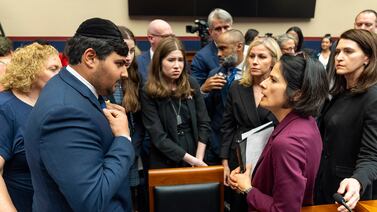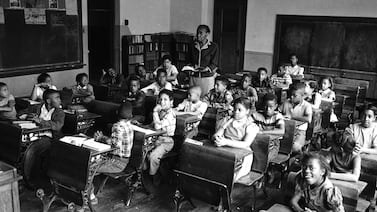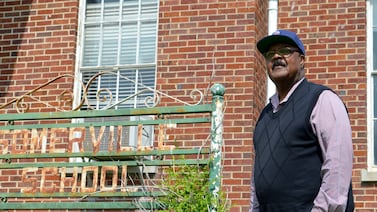Sign up for Chalkbeat Colorado’s free daily newsletter to get the latest reporting from us, plus curated news from other Colorado outlets, delivered to your inbox.
Colorado’s State Board of Education voted Wednesday afternoon to allow Adams 14 to continue its improvement work with a partial outside manager — a sign that the state trusts the progress being made by the long-struggling school district.
Wednesday’s orders are the first time in recent years that the state has not escalated its involvement in Adams 14 but rather signed off on the district’s ongoing plan. Two years ago, the district faced school closures.
Under state law, the State Board must direct improvement in districts such as Adams 14 that have had more than five years of low ratings. The State Board voted 8 to 1 in favor of Adams 14′s continued work, with board member Steve Durham as the only no vote.
One board member, Stephen Varela, said he wished he could vote to take the district off the state’s watchlist for low performance altogether.
Adams 14, a district north of Denver that is 92% percent Latino and serves many low-income families, was one of the first districts in the state to be flagged by the system for multiple years of low performance. Despite many short-lived improvement plans, the district hasn’t been able to improve its ratings in more than 10 years, leading to many firsts as the state tried to escalate its involvement in directing improvement.
On Wednesday, State Board member Lisa Escárcega recalled that she was on the state panel tasked with reviewing Adams 14 and recommending a state intervention 10 years ago. But reflecting back, she said, “We did you no service.”
Over time, the State Board and the department have begun to emphasize working with districts — rather than being in conflict with them — as the best way to achieve good results. The new philosophy emphasizes collaboration over criticism.
“I feel like this has been a book of false starts,” Escárcega said. “If I were to say when did the turnaround work really begin in Adams 14, it was just a few years ago. It wasn’t 10 years ago.”
The new state order will direct the district to continue working with nonprofit partners TNTP, formerly known as The New Teacher Project. The state would have to approve a change in partial managers if the district wanted one.
Adams City High School, the district’s one comprehensive high school, which has also been under state-ordered improvement plans for its own low ratings, now will have a clear separate order to continue its work with outside group ConnectEd on rolling out the school’s career options, called academies, which started for ninth grade students this year.
Officials in the hearing Wednesday discussed how the high school’s latest rating actually would have put it on the path to exit state oversight, but the rating was lowered because not enough students took state tests last spring. The school fell just short of the required 95% participation.
District and high school leaders told the State Board they were disheartened that they had gotten so close but ultimately missed the target. But they said they are optimistic that their improvements will result in better state ratings next fall. They said they’ve worked recently to ensure participation rate is not a problem a second time.
Adams City High School has seen a significant improvement in graduation rates, which by some measures exceed Colorado’s average graduation rates, district leaders said. That is a big factor driving the school’s rating.
Adams 14 Superintendent Karla Loría told the State Board that the district’s work, much of it focused on creating systems for tracking data and how administrators support schools, is working. She added that having the state be more flexible with the district is also key.
“What we have in place is yielding results,” Loría said. “We would like to continue with that structure that we have in place.”
Durham, who voted against the plan for the district and the high school, said he was glad the district was making improvements, but criticized the state’s public education system as a whole for consistently praising and accepting incremental improvements instead of pushing for significant change to double the number of students who can read at grade level.
While Adams 14 data shows progress and growth, the percentage of students who meet or exceed expectations on standardized tests remains low.
The idea of approving the district’s proposed plan to continue working with an outside manager, but not handing over total control to an outside entity, was also in line with recommendations by an external panel that reviewed the district and high school.
The state took public feedback for about a month prior to Wednesday’s hearing, but only received a handful of comments, none from parents or students. The comments submitted were all in support of the district.
Correction: This story was updated to correct the context of State Board member Lisa Escárcega’s quotes.
Yesenia Robles is a reporter for Chalkbeat Colorado covering K-12 school districts and multilingual education. Contact Yesenia at yrobles@chalkbeat.org.








